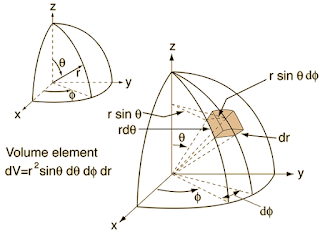The Double Slit with Delta function slits - A rigorous approach
The truest statement about Fourier Transforms is that they are complex. - A.G.S.
Two-slit interference
The interference of light arises from something called Huygen's Principle. It basically states the every point a beam of light reaches becomes a source of a spherical wave. This is seen in the image below (source Wikipedia)

The cylindrical waves will interfere with each other do to the difference in the path length to a point on the screen, \(\Delta\). We see immediately that if \(\alpha = 0\), the waves interfere constructively creating a bright spot. The condition for constructive interference is
\[ \Delta = n \lambda, \ n=0, 1, 2 ...\]
and for destructive interference it is,
\[\Delta = \left(n + \frac{1}{2}\right)\lambda, \ n=0, 1, 2 ... ,\]
where \(\lambda\) is the wavelength of the incident plane wave.

Finding \(\Delta\)
The key value here is \(\Delta\). \(\alpha\) is the most obvious angle to work with, as it natrually defines the position of interest on the screen. However, \(\Delta\) is more naturally related to \(\theta\). To find \(\theta\), we note that
\[\frac{\pi}{2} = \theta + \gamma - \theta_2 \]
\[ \theta = \frac{\pi}{2} - \gamma + \theta_2 .\]
with a pretty good number of lines of geometry we find,
\[\gamma = \frac{\pi}{2} - \frac{\theta_1 - \theta_2}{2}\]
\[\Longrightarrow \theta = \frac{\theta_1 + \theta_2}{2}\]
\)\Delta\) may now be determined using the Law of Sines,
\[ \frac{\sin{(\theta)}}{\Delta} = \frac{\sin{(\phi)}}{d},\]
where \(\phi = \frac{\pi}{2} + \frac{\theta_1 - \theta_2}{2}\). Solving for \(\Delta\),
\[\Delta = \frac{d \sin{(\theta)}}{\sin{(\phi)}}\]
\[\Delta = \frac{d \sin{\left(\frac{\theta_1 + \theta_2}{2}\right)}}{\sin{\left(\frac{\pi}{2}+\frac{\theta_1 - \theta_2}{2}\right)}}\]
\[\Delta = \frac{d \sin{\left(\frac{\theta_1 + \theta_2}{2}\right)}}{\cos{\left(\frac{\theta_1 - \theta_2}{2}\right)}}.\]
This is a wonderfully familiar equation, and it is 100% correct. However, we want this in terms of \(\alpha\) or \(\theta\) as the variable. At this point, the approximation is often made that \(\alpha=\theta\) and the proverbial "they" blast through the problem. However, an interesting blog post that does not make. Instead, lets go through the math manually, and show why and when this approximation is valid. Using the equations,
\[\tan{\alpha} = \frac{y}{L}\]
\[\tan{\theta_{1}} = \tan{\alpha} + \frac{d}{2 L}\]
\[\tan{\theta_{2}} = \tan{\alpha} - \frac{d}{2 L},\]
we derive a form depending only on \(\alpha\),
\[\Delta = \frac{d \sin{\left(\frac{\arctan{\left(\tan{\alpha} + \frac{d}{2 L}\right)} + \arctan{\left(\tan{\alpha} - \frac{d}{2 L}\right)}}{2}\right)}}{\cos{\left(\frac{\arctan{\left(\tan{\alpha} + \frac{d}{2 L}\right)} - \arctan{\left(\tan{\alpha} - \frac{d}{2 L}\right)}}{2}\right)}}\]
Pleasant right! It's immediately obvious what it's behavior is (the author says facetiously). To simplify this, it is easy to show that \(\theta \approx \alpha\) for \(L>>d\) and \(\alpha<<1\) with a Taylor expansion. Simplifying we find
\[\Delta = d\sin{(\theta)} \]
Nulls in the brightness distribution on the screen are located at \(\theta_{null}\) s.t.
\[ \left(n+\frac{1}{2}\right)\frac{\lambda}{d} = \sin{(\theta)} \]
Relating \(\Delta\) to the phase of the waves
The two waves here have a phase difference that oscillates from \(0\) to \(2\pi\) as a function of \(\Delta\). This phase difference of waves is
\[ \varphi = \frac{2\pi \Delta}{\lambda}.\]
The phase difference determines how bright a spot on the screen will be. It will peak where \(\varrho=2\pi n\) and will at a null where \(\varrho=2\pi (n + 1/2)\). This function the sum of two cosines with a phase offset which results in the intensity distribution being,
\[I = \cos^2{\!\left( \frac{2\pi \Delta}{\lambda}\right)}\]



Comments
Post a Comment